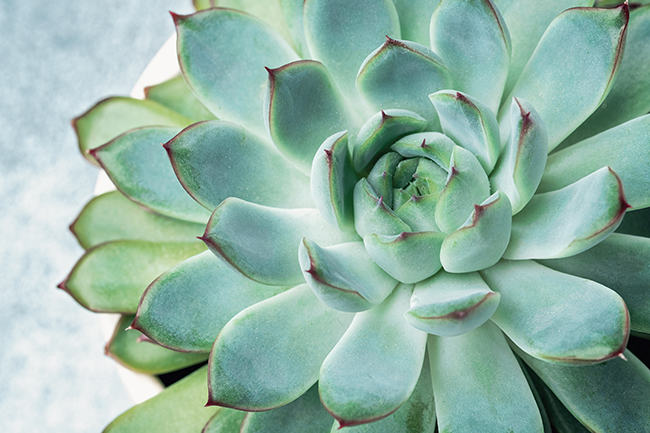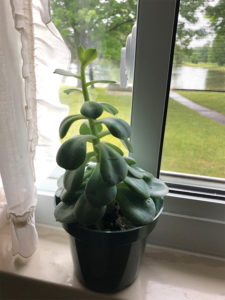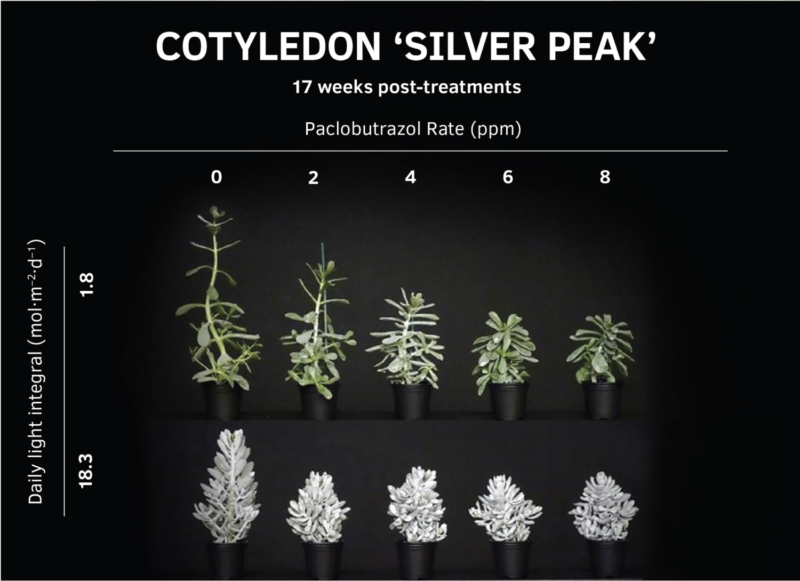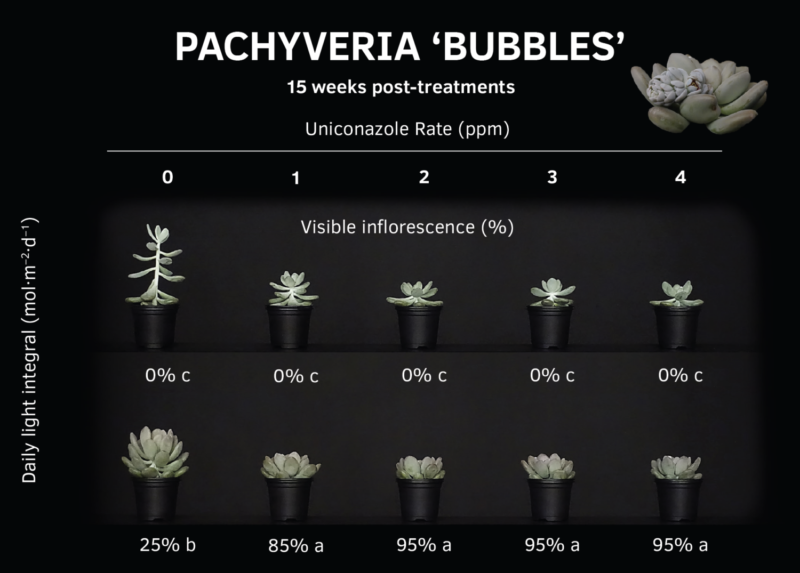
PGRs & Succulents
Succulents have become increasingly popular over the last several years due to their seemingly infinite combination of unique shapes, sizes and colors, as well as being great outdoor and indoor plants. Since most succulents are adapted to arid, high-light environments, they require less frequent waterings than more common tropical houseplants, which drive consumers to purchase them for both indoor and outdoor living and workspaces.

Given that succulents require higher light levels, indoor conditions may not be adequate for balanced plant growth, as shade-intolerant plants will eventually begin to stretch and senesce leaves, and overall plant quality decreases (Figure 1). To address these issues, we hypothesized that a single drench of a plant growth regulator (PGR) such as paclobutrazol or uniconazole could be applied before shipping to potentially reduce stretch, leaf and foliage color loss, and thus increase plant quality and overall customer satisfaction.
THE STUDY
Unrooted stem-tip cuttings of aeonium (Aeonium hybrida) ‘Atropurpureum’, Aeonium leucoblepharum ‘Stripe’, cotyledon (Cotyledon orbiculata) ‘Silver Peak’, crassula (Crassula ovata) ‘Tricolor’, echeveria (Echeveria secunda), Echeveria spp. ‘Elegance Blue’, leatherpetal (Graptopetalum ×Echeveria) ‘Debbie’, kalanchoe (Kalanchoe hybrid) ‘Silver Shadow’, and pachyveria (Pachyphytum bracteosum) ‘Bubbles’ (Dümmen NA Inc., Columbus, Ohio) were received and inserted into 4.5- inch pots filled with 75% of a commercial substrate and 25% coarse perlite.
Twenty-four hours after transplant, cuttings received a 75 ppm foliar spray of IBA (Advocate; Fine Americas Inc., Walnut Creek, California) with a surfactant (Capsil; Aquatrols, Paulsboro, New Jersey) at a volume of 2 quarts/100 square feet to promote uniform rooting. Plants were grown at the Plant Science Research Complex at Michigan State University in a glass-glazed greenhouse at an air temperature of 68° F under a 16-hour photoperiod with high-pressure sodium lamps to provide a daily light integral (DLI) of 12 mol∙m–2∙d–1.
Once plants reached a marketable size where they were well rooted and filled the majority of the pot, baseline measurements were made that included stem length, leaf number, branch number and reproductive status.
After measurements were taken, a uniconazole (Concise; Fine Americas Inc.) drench at a rate of 0, 1, 2, 3, or 4 ppm or paclobutrazol (Piccolo; Fine Americas Inc.) drench at a rate of 0, 2, 4, 6, or 8 ppm was applied, and plants were placed under one of two different DLI treatments of 2, 16, or 18 mol∙m–2∙d–1 [created
via shade cloth (Ludvig Svensson, Kinna, Sweden)] for 10 (kalanchoe), 15 or 17 (all other genera) weeks. Measurements as previously described were repeated every five weeks under each DLI treatment.
WHAT DID WE FIND?
With the exception of cotyledon, a 1 ppm drench of uniconazole was effective at suppressing stem elongation when plants were grown under a DLI of 2 mol∙m–2∙d–1 (which is similar to the light levels received near a home or office window), compared to 16 mol∙m–2∙d–1 (light levels similar to those found in a typical greenhouse during the spring).
For example, untreated kalanchoe plants were 179% taller after 10 weeks under a DLI of 2 mol∙m–2∙d–1 compared to those that were treated with 1 to 4 ppm of uniconazole, which were only 83% to 50% taller, respectively.

For cotyledon, plants were most compact when they received at least a 2 ppm drench of uniconazole and were only 1.2- to 1.6-times taller after 15 weeks, compared to the untreated control which was 5.4-times taller under a DLI of 2 mol∙m–2∙d–1 (Figure 2). Similar trends for uniconazole or paclobutrazol rates and plant height were seen for plants under a DLI of 16 or 18 mol∙m–2∙d–1, respectively.
A single paclobutrazol substrate drench of 2 ppm reduced excessive stem elongation of echeveria and graptopetalum grown under low light for up to 17 weeks. However, cotyledon required a much higher drench rate of 8 ppm paclobutrazol (Figure 3). PGRs were not necessary or effective for aeonium ‘Stripe’ or Crassula, as they did not stretch under our low light conditions.

After 10 or 15 weeks under a DLI of 2 mol∙m–2∙d–1, aeonium ‘Atropurpureum’, cotyledon, echeveria, kalanchoe, and pachyveria senesced 21, 4, 8, 2, and 7 leaves, respectively, compared plants grown under a DLI of 16 mol∙m–2∙d–1. Additionally, aeonium, echeveria, and pachyveria senesced more leaves when they received a 1 ppm of drench of uniconazole, compared to higher rates, regardless of the DLI. Apart from echeveria, all other genera produced more branches under a DLI of 16 or 18 mol∙m–2∙d–1 compared to plants grown under a DLI of 2 mol∙m–2∙d–1.
Aside from all other genera, ≥85% of pachyveria treated with at least 1 ppm of uniconazole initiated inflorescences when grown under a DLI of 16 mol∙m–2∙d–1, compared to 2 mol∙m–2∙d–1 (Figure 4). However, Pachyveria that was grown under a DLI of 2 mol∙m–2∙d–1 did not produce any inflorescences despite receiving a uniconazole application.

Not surprisingly, after 15 weeks, foliage of aeonium ‘Atropurpureum’ was darker and had more red pigmentation under a DLI of 16 mol∙m–2∙d–1 compared to those plants under a DLI of 2 mol∙m–2∙d–1.
Additionally, aeonium ‘Atropurpureum’ treated with at least 1 ppm of uniconazole were slightly less red in foliage color compared to the untreated control. However, paclobutrazol drenches marginally prevented anthocyanin or pigmentation degradation in some genera (Figure 3).
WHAT WE LEARNED
Applying at least a 1 ppm drench of uniconazole on aeonium ‘Atropurpureum’, echeveria, kalanchoe, and pachyveria and at least a 2 or 8 ppm drench of uniconazole or paclobutrazol, respectively, on cotyledon is effective at suppressing stem elongation and leaf loss when plants are grown in low light environments for several weeks. Similarly, at least a 2 ppm paclobutrazol drench was necessary on Echeveria spp. and Graptopetalum.
By applying a PGR drench to these genera before they leave the greenhouse or nursery, plant quality can be extended during shipping, retail and, most importantly, for consumers who are looking to keep succulents in their home, apartment or office space for several months. In conclusion, using a 1 to 2 ppm substrate drench of uniconazole or 2 to 8 ppm paclobutrazol drench can extend the post-production shelf life and quality of succulents exposed to low-light environments found indoors. While PGR drenches are effective at maintaining quality, they are no substitution for providing high light during post-production.
Acknowledgements: We thank Patrick Yates and Michael Ozolins for their assistance in experimental set up and data collection. We would also like to thank Nate DuRussel for greenhouse assistance, Dümmen Orange for plant material, Fine Americas for plant growth regulators, Ludvig Svensson for shade cloth and East Jordan Plastics for pots. This experiment was supported by the Floriculture and Nursery Research Initiative.









 Video Library
Video Library 


















